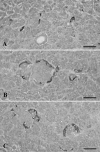An immunohistochemical study of the pancreatic endocrine cells of the Korean golden frog, Rana plancyi chosenica
- PMID: 22472893
- PMCID: PMC3352134
- DOI: 10.4081/ejh.2012.e5
An immunohistochemical study of the pancreatic endocrine cells of the Korean golden frog, Rana plancyi chosenica
Abstract
The regional distribution and quantitative frequency of pancreatic endocrine cells were demonstrated in the Korean golden frog (Rana plancyi chosenica Okada), which is known as a Korean endemic species, for the first time, by immunohistochemical methods using specific mammalian antisera to insulin, glucagon, somatostatin and human pancreatic polypeptide (PP). In the pancreas of the Korean golden frog, all four endocrine cell types were demonstrated. Insulin- and glucagon-positive cells were located in the pancreas as single cells or islet-like clusters with frequencies of 85.90±18.28 and 54.30±8.77/1,000/1,000 cells, respectively. Somatostatin-containing cells were also dispersed in the pancreas as single cells or clusters but in the case of clusters, they are exclusively situated in the marginal regions of insulin- or glucagon-positive cell clusters. Cells stained for somatostatin cell frequency was 15.50±3.10/1000 cells. PP-containing cells were also distributed as single cells or clusters with frequency of 53.40±11.96/1,000 cells. Clusters consisted of PP-positive cells are distributed as a core type and a marginally distributed type. Overall, there were 40.84±3.81% insulin-, 26.02±1.71% glucagon-, 7.63±2.09% somatostatin- and 25.51±3.26% PP-IR cells.
Conflict of interest statement
Conflict of interest: the authors declare no potential conflict of interest.
Figures




Similar articles
-
An immunohistochemical study of endocrine cells in the pancreas of the Red-bellied frog (Bombina orientalis).Eur J Histochem. 2003;47(2):165-72. doi: 10.4081/823. Eur J Histochem. 2003. PMID: 12777214
-
An immunohistochemical study on the pancreatic endocrine cells of the C57BL/6 mouse.J Vet Sci. 2002 Dec;3(4):327-33. J Vet Sci. 2002. PMID: 12819383
-
Immunohistochemical study of the pancreatic endocrine cells in the BALB/c mice: an unique distributional pattern of glucagon.J Vet Sci. 2002 Sep;3(3):167-73. J Vet Sci. 2002. PMID: 12514327
-
An immunohistochemical study of pancreatic endocrine cells in SKH-1 hairless mice.Eur J Histochem. 2002;46(3):229-36. doi: 10.4081/1684. Eur J Histochem. 2002. PMID: 12472118
-
Paracrine control of glucagon release by somatostatin (Review).Int J Mol Med. 2014 Mar;33(3):491-8. doi: 10.3892/ijmm.2013.1605. Epub 2013 Dec 24. Int J Mol Med. 2014. PMID: 24366344 Review.
Cited by
-
On the future contents of a small journal of histochemistry.Eur J Histochem. 2012 Dec 10;56(4):e51. doi: 10.4081/ejh.2012.e51. Eur J Histochem. 2012. PMID: 23361247 Free PMC article.
References
-
- D'Este L, Buffa R, Pelagi M, Siccardi AG, Renda T. Immunohistochemical localization of chromogranin A and B in the endocrine cells of the alimentary tract of the green frog, Rana esculenta. Cell Tissue Res. 1994;277:341–9. - PubMed
-
- Nakajima T, Sasuhara T, Tshikawa O. New frog skin peptides homologous to the ranatensin or bombesin family. In: Miyoshi A, editor. Gut peptides, secretion, function and clinical aspects. Elsevier; Amsterdam, The Netherlands: 1979. pp. 14–18.
-
- Van Noorden S, Polak JM. Hormones of the alimentary tract. In: Barrington EJW, editor. Hormones and evolution. Academic Press; New York, USA: 1979. pp. 791–828.
-
- Etayo JC, Montuenga LM, Sesma P, Diaz de Rada O, Rovira J, Villaro AC. Characterization of pancreatic endocrine cells of the European common frog, Rana temporaria. Gen Comp Endocrinol. 2000;117:366–80. - PubMed
-
- Trandaburu T, Nurnberger F, Ali SS. Distribution and ultrastructure of somatostatin-immunoreactive cells in the pancreas of Rana esculenta. Anat Anz. 1995;177:213–9. - PubMed
Publication types
MeSH terms
Substances
LinkOut - more resources
Full Text Sources
Medical
Miscellaneous

